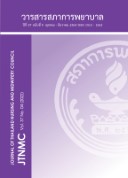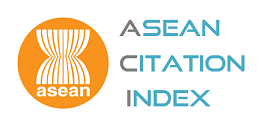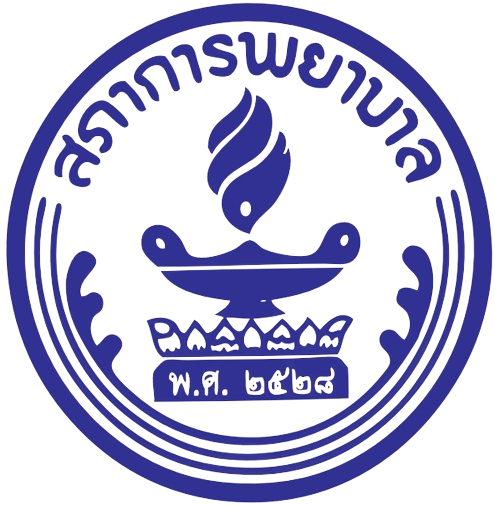การพัฒนารูปแบบการดูแลผู้ป่วยโรคหลอดเลือดสมองในระยะฟื้นฟูสภาพ
คำสำคัญ:
โรคหลอดเลือดสมอง, การฟื้นฟู, พฤติกรรมการจัดการตนเอง, การปฏิบัติกิจวัตรประจำวันขั้นพื้นฐาน, คุณภาพชีวิตบทคัดย่อ
วัตถุประสงค์: เพื่อพัฒนารูปแบบการดูแลผู้ป่วยโรคหลอดเลือดสมองในระยะฟื้นฟูสภาพ และศึกษาผลลัพธ์ของการใช้รูปแบบการดูแลผู้ป่วยโรคหลอดเลือดสมองในระยะฟื้นฟูสภาพ
การออกแบบวิจัย: การวิจัยและพัฒนา (research & development)
การดำเนินการวิจัย: มี 4 ระยะ คือ ระยะที่ 1 วิเคราะห์สภาพปัญหา ระยะที่ 2 พัฒนารูปแบบฯ ระยะที่ 3 ทดลองใช้รูปแบบฯในผู้ป่วยโรคหลอดเลือดสมองชนิดตีบ/อุดตัน จำนวน 2 ราย และปรับปรุง ให้เหมาะสม ระยะที่ 4 นำรูปแบบฯจากระยะที่ 3 ไปใช้และประเมินผลลัพธ์โดยการออกแบบวิจัย กึ่งทดลองแบบ 2 กลุ่มวัดก่อนและหลังการทดลอง กลุ่มตัวอย่างเป็นผู้ป่วยโรคหลอดเลือดสมอง ชนิดตีบ/อุดตัน ตามคุณสมบัติที่กำหนด จำนวน 30 ราย แบ่งเป็นกลุ่มควบคุมและกลุ่มทดลองอย่างละ 15 ราย กลุ่มควบคุมได้รับการดูแลตามปกติ ส่วนกลุ่มทดลองได้รับการดูแลตามโปรแกรมการ จัดการตนเองของผู้ป่วยโรคหลอดเลือดสมองในระยะฟื้นฟูสภาพ เครื่องมือที่ใช้ในการเก็บรวบรวมข้อมูล ได้แก่ 1) แบบสัมภาษณ์ข้อมูลทั่วไป 2) แบบวัดพฤติกรรมการจัดการตนเองของผู้ป่วยโรคหลอดเลือดสมอง ระยะฟื้นฟูสภาพ 3) แบบประเมินระดับความสามารถในการปฏิบัติกิจวัตรประจำวัน 4) แบบประเมินกิจวัตร ประจำวันต่อเนื่อง (Chula ADL Index) 5) แบบวัดคุณภาพชีวิต วิเคราะห์ข้อมูลด้วยสถิติเปรียบเทียบ ผลลัพธ์ภายในกลุ่มด้วย Dependent t-test และเปรียบเทียบผลลัพธ์ระหว่างกลุ่มด้วย Independent t-test
ผลการวิจัย: ผลการใช้รูปแบบการดูแลผู้ป่วยโรคหลอดเลือดสมองระยะฟื้นฟูตามแนวคิด การจัดการตนเอง พบว่ากลุ่มทดลองมีคะแนนเฉลี่ยของพฤติกรรมการจัดการตนเองสูงกว่ากลุ่มควบคุม อย่างมีนัยสำคัญทางสถิติ (p<.01) และมีความสามารถในการปฏิบัติกิจวัตรประจำวันขั้นพื้นฐานสูงกว่า อย่างมีนัยสำคัญทางสถิติ (p<.05) รวมทั้งค่าเฉลี่ยคะแนนคุณภาพชีวิตดีกว่ากลุ่มควบคุมอย่างมี นัยสำคัญทางสถิติ (p<.01) ส่วนความสามารถในการปฏิบัติกิจวัตรประจำวันต่อเนื่อง และการควบคุม โรคร่วม ได้แก่ ค่าเฉลี่ยของน้ำตาลในเลือด ความดันโลหิต และไขมันในเลือด ไม่มีความแตกต่าง กันระหว่างกลุ่มทดลองและกลุ่มควบคุม
ข้อเสนอแนะ: ควรนำรูปแบบการดูแลผู้ป่วยโรคหลอดเลือดสมองระยะฟื้นฟูนี้ ไปใช้ในการดูแล ผู้ป่วยโรคหลอดเลือดสมองระยะฟื้นฟู เพื่อส่งเสริมให้ผู้ป่วยมีการฟื้นหายและมีคุณภาพชีวิตที่ด
Downloads
References
World Stroke Organization. Learn about stroke. [Internet]. [cited 2022 May 16]. Available from: https:// www.world-stroke.org/world-stroke-day-cam- paign/why-stroke-matters/learn-about-stroke
Division of Non-Communicable Diseases. Department of disease control. Ministry of Public Health. [Internet]. Thaincd.com. [cited 2022 May 23]. Available from: http://thaincd.com/2016/mission/documents-detail.php?id=13684,&tid=32&gid=1-020
Department of Disease Control. Ministry of Public Health. Information for responses to cardiovascular disease service plans [Internet]. 2020 [cited 2022 May 23]. Available from:https://hdcservice.moph.go.th/hdc/reports/page.php?cat_id=39fd-60c25235db479930db85a0e97dd3
Betts KA, Hurley D, Song J, Sajeev G, Guo J, Du EX, et al. Real-world outcomes of acute ischemic stroke treatment with intravenous recombinant tissue plasminogen activator. J Stroke Cerebrovasc Dis [Internet]. 2017 [cited 2022 May16]; 26(9):1996–2003. Available from: https://pubmed.ncbi.nlm.nih.gov/28689999/
Thasanapoonchai D. Stroke signs of the risk of paralysis. [Internet]. 2017 [cited 2022 May 23]. Available from: http://www.sikarin.com/content/detail/131/stroke-
Smitasiri T, Jantararotai W. Outcomes of acute ischemic stroke patients treated with intravenous recombinant tissue plasminogen activator in Chonburi Hospital. Chonburi Hospital Journal. 2021; 46(3):195–204. (in Thai)
Phakdeewiwat P, Liangchawengwong S, Muengtaweepongsa S. The factors predicting the mobility of stroke patients during the first year of stroke. Journal of The Royal Thai Army Nurses. 2018; 19 Suppl May-August 2018:S185–93. (in Thai)
Kok G, Gottlieb NH, Peters G-JY, Mullen PD, Parcel GS, Ruiter RAC, et al. A taxonomy of behaviour change methods: an intervention mapping approach. Health Psychol Rev [Internet]. 2016 [cited 2022 May16]; 10(3):297–312. Available from: http://dx.doi.org/10.1080/17437199.2015.1077155
Tepsuwan J. The effects of recurrent prevention program for stroke patients at a tertiary level hospital in Nakhon Pathom Province. J Thai Stroke Soc [Internet]. 2019 [cited 2022 May16]; 17(1):5-18. Available from: https://he01.tci-thaijo.org/index.php/jtss/article/view/172051
Lorig KR, Holman H. Self-management education: history, definition, outcomes, and mechanisms. Ann Behav Med [Internet]. 2003 [cited 2022 May16]; 26(1):1–7. Available from: http://dx.doi.org/10.1207/S15324796ABM2601_01
Lorig KR, Sobel DS, Stewart AL, Brown JrBW, Bandura A, Ritter P, et al. Evidence suggesting that a chronic disease self-management program can improve health status while reducing hospitalization: a randomized trial. Med Care 1999; 37(1):5-14.
Komton V. Stroke patient’ self-management: application of empirical evidence. Thai Journal of Nursing Council. 2019; 34(1):25-41. (in Thai)
Department of Medical Services, Ministry of Public Health. Elderly screening / assessment guide. 2th ed. Bangkok: office of printing works veterans relief organization; 2015.
Intaboot K. The effect of a self-management and social support program on new hypertension cases with uncontrolled blood pressure. ODPC 9 J. 2020; 26(1):73-83. (in Thai)
Bernard R. Fundamentals of biostatistics. 5thed. Duxbery: Thomson learning; 2000.
Cronbach LJ. Coefficient alpha and the internal structure of tests. Psychometrika. 1951; 16(3): 297-334.
Noppakraw J, Chintanawat R, Khampolsiri T. Health literacy and self-management in older persons with type 2 diabetes mellitus. Nursing Journal. 2017; 47(2):251–61. (in Thai)
Neurological Institute of Thailand. Clinical practice guidelines for stroke rehabilitation. Thaineuronurse [Internet]. 2007 [cited 2022 May 23]. Available from: http://thaineuronurse.com/cnpg/9.pdf
Jitapunkul S, Kamolratanakul P, Ebrahim S. Disability among thai elderly living in Klong Toey Slum. Journal of Medical Association of Thailand. 1994;77:231-8. (in Thai)
Thangkratok P, Posai V, Pipatsombat P, Trainattawan W, Suksatan W. Validity and reliability of the thai version of the stroke specific quality of life scale. Journal of Medical Health Science. 2019; 26(3):33-43. (in Thai)
Puangchan K, Jinawin S. Effects of using a nursing practice guidelines for the care of acute thrombotic or ischemic stroke patients, Phrae Hospital. Journal of the Phrae Hospital. 2020; 28(2):1-17. (in Thai)
Krajangkaew N. Effects of skill training program for caregivers of dependent stroke patients while in hospital. [Thesis]. Chiang Mai Neurological Hospital. 2022.
Kesornsunt P, Khanunthong N, Pansuwan K, Plychumpol W. Development of caring system by IDEAL patient care model for acute ischemic stroke patients at Chaoprayayomarat Hospital. Journal of Nursing and Health Care. 2017;35(2):111-21. (in Thai)
Maneechompu S. The factors influencing the self-care agency and quality of life of patients with stroke patients. [Thesis]. Chiang Mai Neurological Hospital. 2019.
Wangtapan K, Komphayak J, Seekao O. Stroke prevention self-management program in patient with uncontrolled hypertension. Research and Development Health System Journal. 2020;13(1):422-30. (in Thai)
Joychoo N, Pinyopaskul W, Charoenkitkarn V. Relationship among age, perceived benefits of health behaviors, perceived barriers of health behavior and health behaviors in patients with ischemic. Ramathibodi Nursing Journal. 2014;20(2):236-48. (in Thai)
Chodnock K, Panomai N. Factors affecting to self-care behavior of stroke patients in Bueng Kan Hospital, Bueng Kan District, Bueng Kan Province. North-Eastern Thai Journal of Neuroscience. 2018;13(2):38-55. (in Thai)
KongKaew O. Illness representation and recurrence prevention behaviors in elderly with stroke. [Thesis]. Prince of Songkla University; 2017.
Mahasook S. The effect of information, motivation, hand and arm rehabilitation program on activity of daily living among older persons with stroke. [Thesis]. Chulalongkorn University; 2014.
Chuejedton R, Tamdee D. Factors related to quality of life among stroke survivors. Journal of Associated Medical Sciences. 2017; 50(3):597-604. (in Thai)
Moonsarn S, Sumpowthong K. Effects of dietary behavior modification program guideline of the DASH with self-efficacy theory and social support on reducing the risk of hypertension among pre-hypertensive pateints. The Public Health Journal of Burapha University. 2016;11(1):87-98. (in Thai)
Saitree R, Chaimay B, Woradets S. Activities of daily living among stroke patients. Academic Journal of Community Public Health. 2019;5(2):1-13. (in Thai)
Wannakhao S, Danyuthasilpe C, Siripornpiibul T. Effects of a self-management program on blood pressure levels and self-management behaviors among elderly with hypertension in Uttaradit Province. Boromarajonani College of Nursing, Uttaradit Journal. 2019; 11(1): 126-41. (in Thai)
Jaisit J, Meetam R, Kamkan P. Effect of self-management support program on self-management behaviors and hemoglobin A1C level among persons with type 2 diabetes. Journal of Nursing Science & Health. 2017; 40(2):65-73. (in Thai)
Downloads
เผยแพร่แล้ว
How to Cite
ฉบับ
บท
License
Copyright (c) 2022 วารสารสภาการพยาบาล

This work is licensed under a Creative Commons Attribution-NonCommercial-NoDerivatives 4.0 International License.







